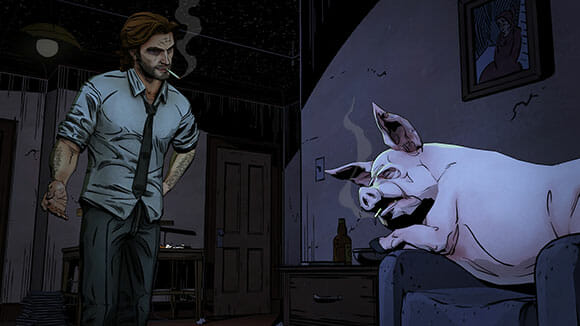
By now it seems a little redundant to point out that fairy tales as, say, collected by the Brothers Grimm were pretty gruesome. In Telltale Game’s The Wolf Among Us, set in a “gritty” (read: dirty, cigarette-addled 1970s-ish) New York City neighborhood populated by fairy tale characters, someone takes an axe to the skull before you even get to the title screen.
About that setting: the game is based on the Vertigo comic Fables which tells the stories of characters who escaped from their world and who now live in Fabletown, a neighborhood in a “real world” New York City (See ABC’s Once Upon a Time for a similar, Disney-branded take on this idea). It’s in a noirish New York, all shadows and saturated colors. The lines are thick and there’s a stillness to the art and animation that feels true to the game’s origins as a comic book.
A lot of the Fables comics are genre fiction set in the fairy tale urban world—Wolf is a murder mystery peppered with references to stories and, I assume, to the comic itself. A lot of what happens messes around with genre standards, but this kind of intellectual genre-combining raises a question: Is the collision of cliches and stereotypes enough to elevate them? Does the slumlord really need to have a working-class British accent? Is mashing the femme fatale into the fairy tale princess into the victimized sex worker doing anything other than finding a way to repackage those ideas? It’s an issue not unique to Wolf or to its source material, the idea that a stack of references is in itself worthwhile.
The Big Bad Wolf is the sheriff of the Fabletown. He goes by Bigby Wolf, and looks quite the frumpled cop with his loose tie and unbuttoned collar. Oh, he’s in human form, so he’s not a giant anthropomorphic dog. Like any detective in this kind of city, he’s guilty about things in his past and trying to make up for them because the city, all its dirt and violence, is a metaphor. For his guilt. About destroying pigs’ houses and eating people.
You walk Wolf around apartment buildings and city streets, reading plaques, talking to people and animals, picking up items. Snow White, assistant to the acting mayor of Fabletown, comes along. She’s the calm to Wolf’s smolder, a blueish tint to her palette complementing his reddishness. She asks a lot of questions and waits for you to decide whether to peek in someone’s door or knock on it.
You do a little library research. During action sequences (fights and chases) you press buttons as they appear on-screen, usually placed in a spot where the image’s composition leads your eye. Sometimes you guide a cursor near a circle before the button you need to press will appear. Sometimes there’s more than one circle, presenting you with a choice: Do I throw the guy onto the metal bed frame or into the sink?
At the beginning of the game it tells you that your choices matter, and that the story tailors itself to them. Without seeing the entire game (this few hours is the first of five episodes), it’s hard to say whether that’s delivered upon in the game’s structure or just more weird choice-as-empowerment marketing that is so videogames. And what does “matter” even mean?
Text will appear in the upper-left hand corner, giving you clear feedback on the effect of your actions. Or, well, sort-of clear feedback: It will tell you if you chose something, or if your interactions with a character had an immediate effect on them (“She noticed your silence” or “He’ll remember that”). You don’t know what the long-term effects of it will be, though, but it’s a particularly gamey kind of foreshadowing, the equivalent of an ominous chord or a lingering cutaway shot.
Does it matter if I anger one of these characters? Does it matter if it matters? Most games with conversations give you as much time as you want to decide what your character is going to say next, modeling conversations as a series of turns taken by the participants. It’s a style that feels less stilted in games where you’re reading the dialogue. When there’s voice acting, though, the flow of conversation gets interrupted by these pauses where you’re selecting what to say next. Wolf’s conversations have a timer and if you haven’t chosen an option by the time it runs out, the scene continues with a default dialogue option being chosen.
This sidesteps an issue that games with multiple choices have: Since the action never stops and waits for you, the camera and the editing don’t have to stop and wait for you.
Telltale manages to simulate Hollywood cinematography and editing techniques, the angles and timings honed over a hundred years to erase as much of the technology as possible. So when the image freezes for a bit before cutting to the next image (a result of the images being rendered in real-time by the game, not animated beforehand), it’s a bit jarring. But then it’s wonderful, because it’s the game system poking its head out from behind the scenes and reminding you that it’s there, and that you’re there, and that it’s really impressive that you forgot to pay attention to both of those facts for a little while.
But when everything’s running smoothly, it manages to hide the little inconsistencies, or to make you not care that were you to, say, reload the scene and play the opening four different times and do four different things, the game eventually reacts to you the same way: Wolf gets a headbutt and women lose their heads.
The Wolf Among Us was developed by Telltale Games. It is available for the Xbox 360, PlayStation 3, PC and Mac.
Brian Taylor likes solving mysteries but kind of wishes so many of them didn’t involve mutilated women.
